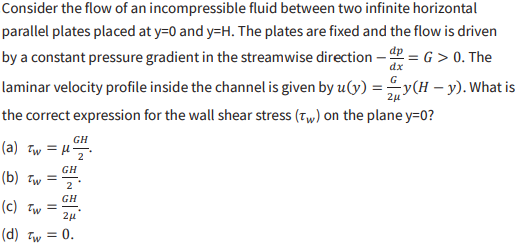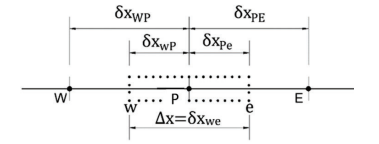MEC320 - 2023-24 Paper Qs
1/19
There's no tags or description
Looks like no tags are added yet.
Name | Mastery | Learn | Test | Matching | Spaced |
|---|
No study sessions yet.
20 Terms
What is the physical meaning of the convective derivative?
(a) The time rate of change following a moving fluid element.
(b) The time rate of change at a fixed point.
(c) The time rate of change due to the movement of the fluid element from one location to another in the flow field where the flow properties are spatially different.
(d) None of the above.
c) The time rate of change due to the movement of the fluid element from one location to another in the flow field where the flow properties are spatially different.
Select the correct answer that mathematically describes a 3D, steady-state compressible flow.
a) \frac{\partial (\rho u)}{\partial x} + \frac{\partial (\rho v)}{\partial y} + \frac{\partial (\rho w)}{\partial z} = 0
b)\frac{\partial(\rho}{\partial(t)}+\left\lbrack\frac{\partial(\rho u)}{\partial x}+\frac{\partial(\rho v)}{\partial y}\right\rbrack=0
c)\frac{\partial u}{\partial x}+\frac{\partial v}{\partial y}+\frac{\partial w}{\partial z}=0
d)\frac{\partial\rho}{\partial t}+\frac{\partial u}{\partial x}+\frac{\partial v}{\partial y}+\frac{\partial w}{\partial z}=0
a) \frac{\partial (\rho u)}{\partial x} + \frac{\partial (\rho v)}{\partial y} + \frac{\partial (\rho w)}{\partial z} = 0
In a fully developed flow within a straight channel with its axis along the x direction, which of the following term is negligible?
(a) du/dx
(b) du/dy
(c) Both du/dx and du/dy
(d) None of the terms are negligible.
a) du/dx

.Consider the flow of an incompressible fluid between two infinite horizontal parallel plates placed at y=0 and y=H. The plates are fixed and the flow is driven by a constant pressure gradient in the streamwise direction -dp/dx = G > 0. The laminar velocity profile inside the channel is given by u(y) = (G/2μ)y(H-y). What is the correct expression for the wall shear stress (τw) on the plane y=0?
a)\tau_{w}=\mu\frac{GH}{2}
b)\tau_{w}=\frac{GH}{2}
c)\tau_{w}=\frac{GH}{2\mu}
d)\tau_{w}=0
b)\tau_{w}=\frac{GH}{2}
What is u+?
a) The ratio of velocity parallel to the wall to the friction velocity
b) The ratio of the friction velocity to velocity parallel to the wall.
c) The ratio of free-stream velocity to friction velocity.
d) The ratio of friction velocity to free-stream velocity
a) The ratio of velocity parallel to the wall to the friction velocity.
The terms in the momentum equations accounting for turbulence effects contain ____________.
a) Reynolds stresses
b) Turbulent kinetic energy
c) Dissipation of turbulent kinetic energy
d) Length scale terms
a) Reynolds stresses
Which of these scientists introduced turbulent viscosity?
a) Kolmogorov
b) Smagorinsky
c) Prandtl
d) Boussinesq.
d) Boussinesq
The kinematic turbulent viscosity is __________.
a) equal to the product of turbulent length and time scales
b) equal to the product of turbulent length and velocity scales
c) proportional to the product of turbulent length and velocity scales
d) proportional to the product of turbulent length and time scales
c) proportional to the product of turbulent length and velocity scales
Express the turbulence length scale in terms of k and ε.
a)(\frac{k}{\epsilon})^{\frac32}
b)(\frac{k^{\frac32}}{\epsilon})
c)(\frac{\epsilon}{k^{\frac32}})
d)(\frac{\epsilon}{k})^{\frac32}
b)(\frac{k^{\frac32}}{\epsilon})
Which of the following model is not an eddy viscosity turbulence model?
a) Standard k-e model,
b) Mixing length model
c) Reynolds stress model
d) K-omega SST model
c) Reynolds stress model.
Wall function can be used when the first node satisfies ___________.
a) y+ < 1
b) 1< y+ < 30
c) 30 < y+ < 300
d) y+ > 300
c) 30 < y+ < 300
Which of these properties is not ensured in Finite Difference Methods?
a) Stability
b) Convergence
c) Conservativeness
d) Accuracy.
c) Conservativeness

Consider the following stencil.
The discretized form of
(d\phi/dx)_{w}
using the central differencing scheme is:
a)\dfrac{\phi_{P}+\phi_{W}}{\delta x_{WP}}
b)\dfrac{\phi_{P}-\phi_{W}}{2}
c)\dfrac{\phi_{P}-\phi_{W}}{\delta x_{WP}}
d)\dfrac{\phi_{P}+\phi_{W}}{2}
c)\dfrac{\phi_{P}-\phi_{W}}{\delta x_{WP}}
The numerical convection schemes should be _________.
a) upwind biased
b) downwind biased
c) upwind or downwind depending on the problem
d) considering both upwind and downwind equally
a) upwind biased

The diagram below represents a one-dimensional mesh with vertical lines representing the control volume faces. The conservation equations are applied to which of these points while discretizing the equation using the Finite Volume Method?
5, 6, 7
Select the correct statement.
a) Explicit method is unconditionally stable.
b) Explicit method requires no iterations and hence cheap to run.
c) Explicit method requires CFL (Courant-Friedrichs-Lewy number) > 1.
d) Explicit method is second order accurate.
b) Explicit method requires no iterations and hence cheap to run.
The pressure correction equation is used to ensure _________.
a) energy conservation
b) velocity conservation
c) momentum conservation
d) mass conservation
d) mass conservation
If the simulation oscillates and hence does not converge, which of the following actions cannot be used to overcome this problem?
a) Reducing relaxation factors
b) Checking mesh quality
c) Reducing convergence tolerance
d) Using an improved initial flow
c) Reducing convergence tolerance.
Which of the following traits is not a measure of the quality of mesh?
a) Aspect ratio
b) Order of accuracy
c) Smoothness
d) Skewness.
b) Order of accuracy
If the tolerance value to stop the iteration is too big, which of these properties will be affected?
a) Accuracy
b) Efficiency
c) Stability
d) Conservativeness
a) Accuracy